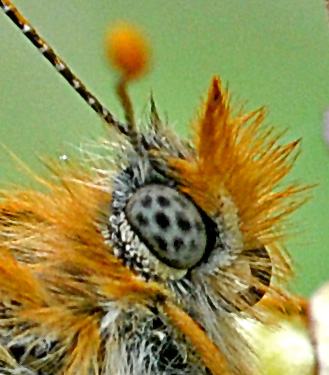 While the human eye has just one single lens, insects view their environment with an compound eye consisting of thousands of ommatidia. Each has its own set of photoreceptors to receive visual signals: Bees have six green receptor cells responsible for motion vision and small target detection as well as one or two UV and blue receptors (Lars Chittka/Nigel E. Raine: Recognition of Flowers by Pollinators. In: Current Opinion in Plant Biology 2006, p.429).
While the human eye has just one single lens, insects view their environment with an compound eye consisting of thousands of ommatidia. Each has its own set of photoreceptors to receive visual signals: Bees have six green receptor cells responsible for motion vision and small target detection as well as one or two UV and blue receptors (Lars Chittka/Nigel E. Raine: Recognition of Flowers by Pollinators. In: Current Opinion in Plant Biology 2006, p.429).
Other insects like the swallowtail Papilio glaucus have also red receptors – as butterflies generally have a better ability to recognize colours than
bees (Adriana Briscoe: What colors do insects see? In: Orchid Digest 2005, p.265). The resolution of the compound eye is about 100 times worse than that of the human eye. Bees are near-sighted: A flower needs a giant size of 26 cm in diametre to be recognized in a distance of 1 meter; for viewing a 1 cm diameter flower a bee has to shorten its distance to 11.5 cm (Chittka/Raine 2006, p.428f.).
Much better than sight is the odor perception of insects with bees having at least 130 receptors in their antennae.
It would be a good evolutionary strategy to develop enormous flowers in order to attract pollinators. But larger flowers are more energetically costly to produce and flower size is constrained by a complex series of interactions between the genes and processes governing organ development (Heather M. Whitney/Beverley J. Glover: Morphology and development of floral features recognised by pollinators. In: Anthropod-Plant Iteractions 2007, p.148). Flower shape is more variable, but not as variable as its colour which is regulated by genes, enzymes, metal ions and pH value. There have been experiments showing that both bumblebees and hummingbirds exhibit strong discrimination on the basis of petal colour. These results make it likely, although not certain, that colour is the only significant factor in the choices made by pollinators (Whitney/Glover 2007, p.153).
It seems that insects are learning the colours and shapes of flowers which have awarded them with nectar. Since many orchids don‘t produce nectar it may be vital for them to be mistaken for a plant rewarding its visitor with nectar.
But a successful pollination depends on multiple factors which are beyond the control of the individual plant or species (Chittka/Raine 2007, p.433).
One decisive factor is the vicinity of other flowers. Since white, UV-absorbing (typically bee bluegreen) flowers are the most common in practically all temperate European and Mediterranean habitats (Chittka/Raine 2007, p.433),
it might be a good strategy to develop white flowers: An orchid with a common color can be fairly sure to find itself in the vicinity of other flowers with similar color (Chittka/Raine 2007, p.434).
In addition to colour, the patterns of petals may as well influence the way how insects recognise flowers. The lines and blotches on petals and sepals generate a “flicker” effect due to their changing light intensity while an insect is flying over a flower with a marked pattern, and in experiments the bees preferred those (flowers) with the most flicker (Harold Koopowitz: More on Insect Vision in Flowers. In: Orchid Digest69/2005. p.267). In some albiflora varieties of orchids the colour of the petal pattern is preserved, while the surrounding area has lost all its pigments. But pure white flowers may have their own patterns as well, created by UV absorbing flavonols in the flower cells: Flowers that are visited by insects with eyes sensitive to ultraviolet light often have patterns or markings that the insects are sensitive to, but which humans cannot see (Koopowitz 2005, p.268).